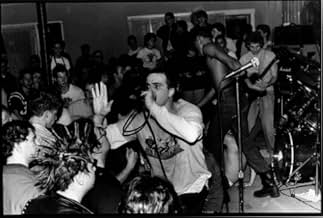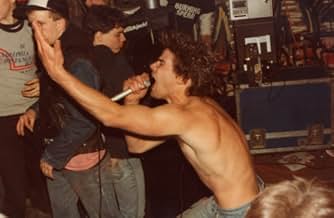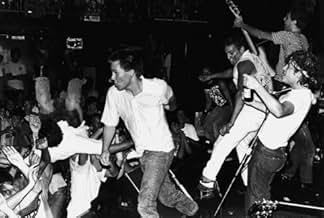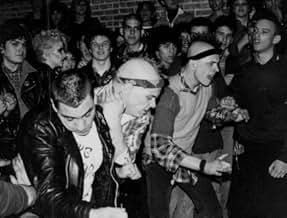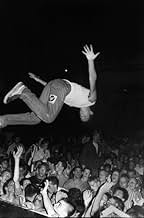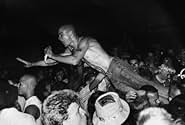IMDb RATING
7.3/10
3.7K
YOUR RATING
The History of American Punk Rock 1980-1986The History of American Punk Rock 1980-1986The History of American Punk Rock 1980-1986
James Drescher
- Self
- (as Jimmy Gestapo)
Joe Keithley
- Self
- (as Joey 'Shithead' Keithley)
David Markey
- Self
- (as Dave Markey)
Featured reviews
OK, As you would expect the footage of the bands in their prime is absolutely incredible... made me want to stage dive in the theater. the interviews of some of hardcore's icons lived up to my expectations - Keith morris, Ian Mackaye and Henry Rollins always have memorable sound bites - but the director also made sure to include lesser known "musicians" like the dudes from heart attack, die Kreuzen and death piggy. HOWEVER, my biggest complaint was the lack of a fully descriptive storyline and the exclusion of "non-thrash" hardcore bands As with most punk documentaries the opening setting really drew me in by explaining the social, cultural and political backdrop that spawned the scene. Surprisingly, there is almost no footage of the 77-80 punk rock influences that shaped hardcore...no Ramones or pistols or even fear or the germs and other just Pre-hardcore bands. it jumps right into the thrash full throttle, but unfortunately tries to let said footage carry the documentary, which it does not always do.
Again, as with most punk documentaries, this one struggles to end. it builds up the scene, describes some of the regional tribes - affording WAY too much time to Boston and really skimping on Texas and the entire Midwest - and then realizes it's got to end somehow. The movie is a real jumble. It doesn't get into the "kids" that much (i can't think of any regular "fans" who were interviewed. everyone was either in a band or ran a label or was the girlfriend of a major player.) and does not detail just what kind of people were attracted to hardcore outside of the generic explanation of "angry outcasts" from the suburbs. (like what's the difference between a Misfits fan and your run of the mill Iron Maiden fan.) It doesn't really timeline the rise, peak and decline of the era. the interviewees just say how awesome and crazy and new it was, dude, the Bad Brains rule, and then Ian Mackaye realizes fighting is "uncool" (although fighting was totally awesome in '81) and then DYS and SSD really start to suck and it's all over by '86. Excessive intra-scene violence is mentioned, but except for Rollins pummeling a dude in a separate scene - no fighting footage is shown (there's got to be TONS of fight footage!). no mention of big labels coming in and trying to commodify the scene and no reference to metal bands incorporating hardcore beats to create thrash metal or how many of the HC participants led the college rock/indie movement of the late 80s into the 90s alternative explosion (although i'm glad they didn't end the film with Nirvana & Green Day). i realize the documentary is about HC, but the scene didn't just end, the music and the people just changed form. (on a side note, anyone involved in the hardcore scene after '86 will once again be frustrated by the blanket statement that the scene just ended one day and not the more sensible opinion that a new generation of kids have continually created new and different waves of HC scenes through the years...even if the newer scenes weren't as good it's a real slap in the face to suggest bands like YoT, Citizens Arrest, Integrity, Los Crudos, Tragedy and many more are not HC....MRR still publishes for Christsakes).
This leads me to my second point that the range of bands covered - except for flipper and the Nig heist - were only awesome thrash bands. (yes, i know it's a strange complaint.) no reference to husker Du or the Butthole surfers and how those bands pushed the musical boundaries of HC or footage of some funky big boys or minutemen songs which would spotlight how bands like the chili peppers/faith no more would tweak the HC sound and successfully sell it to millions. i know you can't show every band from the era, but if you added the aforementioned bands and subtracted some (admittedly Slammin') YDI and Scream footage it may have shown the broader impact of that original HC scene. i should note that a couple obvious bands had to be omitted for legal reasons and a couple of your favorites were probably cut out in editing... mine being the Descendents, red cross, naked Raygun, AOD and GG Allin and the jabbers. i really don't know how to end this review... the archival footage is amazing and i'm glad this era of punk rock has finally been given the documentary treatment, but if you're not a crazy hardcore punk fan such as myself, you may get kinda bored after 45 minutes...just ask my girlfriend.
Again, as with most punk documentaries, this one struggles to end. it builds up the scene, describes some of the regional tribes - affording WAY too much time to Boston and really skimping on Texas and the entire Midwest - and then realizes it's got to end somehow. The movie is a real jumble. It doesn't get into the "kids" that much (i can't think of any regular "fans" who were interviewed. everyone was either in a band or ran a label or was the girlfriend of a major player.) and does not detail just what kind of people were attracted to hardcore outside of the generic explanation of "angry outcasts" from the suburbs. (like what's the difference between a Misfits fan and your run of the mill Iron Maiden fan.) It doesn't really timeline the rise, peak and decline of the era. the interviewees just say how awesome and crazy and new it was, dude, the Bad Brains rule, and then Ian Mackaye realizes fighting is "uncool" (although fighting was totally awesome in '81) and then DYS and SSD really start to suck and it's all over by '86. Excessive intra-scene violence is mentioned, but except for Rollins pummeling a dude in a separate scene - no fighting footage is shown (there's got to be TONS of fight footage!). no mention of big labels coming in and trying to commodify the scene and no reference to metal bands incorporating hardcore beats to create thrash metal or how many of the HC participants led the college rock/indie movement of the late 80s into the 90s alternative explosion (although i'm glad they didn't end the film with Nirvana & Green Day). i realize the documentary is about HC, but the scene didn't just end, the music and the people just changed form. (on a side note, anyone involved in the hardcore scene after '86 will once again be frustrated by the blanket statement that the scene just ended one day and not the more sensible opinion that a new generation of kids have continually created new and different waves of HC scenes through the years...even if the newer scenes weren't as good it's a real slap in the face to suggest bands like YoT, Citizens Arrest, Integrity, Los Crudos, Tragedy and many more are not HC....MRR still publishes for Christsakes).
This leads me to my second point that the range of bands covered - except for flipper and the Nig heist - were only awesome thrash bands. (yes, i know it's a strange complaint.) no reference to husker Du or the Butthole surfers and how those bands pushed the musical boundaries of HC or footage of some funky big boys or minutemen songs which would spotlight how bands like the chili peppers/faith no more would tweak the HC sound and successfully sell it to millions. i know you can't show every band from the era, but if you added the aforementioned bands and subtracted some (admittedly Slammin') YDI and Scream footage it may have shown the broader impact of that original HC scene. i should note that a couple obvious bands had to be omitted for legal reasons and a couple of your favorites were probably cut out in editing... mine being the Descendents, red cross, naked Raygun, AOD and GG Allin and the jabbers. i really don't know how to end this review... the archival footage is amazing and i'm glad this era of punk rock has finally been given the documentary treatment, but if you're not a crazy hardcore punk fan such as myself, you may get kinda bored after 45 minutes...just ask my girlfriend.
I remember reading a review of American Hardcore in one of the weeklies in Portland. It stated something to the extent that if you know hardcore, you will not learn anything and if you know nothing about hardcore, you won't learn much. I can't agree more.
As someone that has a fair amount of knowledge of the history of the American Hardcore movement, I don't feel like I learned much new about hardcore. And, I have talked to others that know little about hardcore and they had a hard time tracking.
I was also surprised about some of the things that were missing. How could Maximum Rock n' Roll be left out? Maybe the Dead Kennedys were left out because of all the legal stuff going on with them now or maybe because a lot of old punks don't like them now. I know there is only so much room and info someone can squeeze into two hours, but it is hard to see how certain things were left out of it.
I think it was a good attempt. The director should have made a better decision and either make it a movie for someone that knew nothing or a movie for the more advanced viewer. Still, if you are a fan of hardcore or you are perhaps a younger viewer that has some interest in the hardcore punk movement of the early 80's, it is worth renting.
As someone that has a fair amount of knowledge of the history of the American Hardcore movement, I don't feel like I learned much new about hardcore. And, I have talked to others that know little about hardcore and they had a hard time tracking.
I was also surprised about some of the things that were missing. How could Maximum Rock n' Roll be left out? Maybe the Dead Kennedys were left out because of all the legal stuff going on with them now or maybe because a lot of old punks don't like them now. I know there is only so much room and info someone can squeeze into two hours, but it is hard to see how certain things were left out of it.
I think it was a good attempt. The director should have made a better decision and either make it a movie for someone that knew nothing or a movie for the more advanced viewer. Still, if you are a fan of hardcore or you are perhaps a younger viewer that has some interest in the hardcore punk movement of the early 80's, it is worth renting.
"Ameican Hardcore," is a pretty good documentary for those even a bit interested in the genre. Personally I found it heavily lacking in a number of departments. The film itself was put together pretty well over all and moves along at a good pace. What is lacking though is the appreciation of the entire other side of the West Coast scene. Most of the bands from San Francisco, or who centered themselves from S.F. were not covered at all. Obviously someone did not want to include Jello Biafra and DK, but whatever, they were there and they were important to the scene. Those from the mid-west probably felt a bit slighted by the fact that the Crucif*cks were not included as well. Way to many major bands were not even mentioned and it was very irritating. Overall this documentary was just okay. I was expecting much more considering that the book "American Hardcore" was quite a bit more thorough overall.
Growing up in the early 1980s in one of the punk hot spots (Austin), I just had to see this film the first day it was out. I can remember like yesterday seeing the Big Boys, the Dicks, DK and Black Flag at Club Foot, the punk venue. It was a great and unique time. I have aged, but still consider myself a punk at heart. However, I was rather letdown by this film. It seems like the guy wanted to make this definitive documentary over the punk scene in the early '80s, but half the people he asked to interview turned him down. The most glaring flaw with this film is the omission of the Dead Kennedys. Yes, Black Flag and the Circle Jerks were huge during that time, but NOBODY came close to rivaling DK, they were it. Yet, there is nothing in the film about them, nothing. Fear is also ignored and so many other greats are just barely touched on. Yet, we get a ton of stuff on the Cro Mags and TSOL? Look, I know that a documentary filmmaker can only use the sources available to him, but it seems that the sources that were available to him (minus Henry Rollins and Keith Morris) were rather small in comparison to other giants like Jello Biafra and Lee Ving. Moreover, there was not enough music in the film. It opens with a nice Bad Brains' cut and montage and then they kind of go away from anymore montages. As someone that experienced the scene firsthand, I just kind of felt it was a rather thin and sloppy look at a very interesting time. Moreover, they drop Husker Du's name a lot, but then never explore anything about them. The guy could have made a better documentary, a much better one. And he could have shown how the punk scene influenced the creation of future bands like Social Distortion, the Replacments, etc.. And how about a shout-out to the freaking Ramones!?
Just came out of a preview screening of this fine film here at the Natfilm festival in Copenhagen, Denmark! In short, 'American Hardcore' lives up to the expectations: Made in a D.I.Y. fashion befitting its' subject, it gives you an excellent overview of the first wave of American hardcore music, nicely balancing the violence that characterized the early days with the positive message that came out of it.
You'll get to see lots and lots of never-seen-before amateur footage from (really) early hardcore shows, interwoven with many, many, many excellent interviews with key figures from the scene.
Fact is, the filmmakers have managed to dig up pretty much everybody who was a nobody back in the day: Where one could have expected a long line of New York art critics, psychologists, social anthropologists and the like yakitiyaking away about form and substance, with perhaps a single Henry Rollins getting to represent the "hardcore punk subculture" as a whole, instead what you get is a literal who's-who of early American hardcore: You've got your Gang Green and your Circle Jerks, your SS Decontrol and your Jerry's Kids, your Negative F/X and your Cro-Mags, and so on and so forth.
On a side-note, some personal favorites will inevitably be missing from any such line-up -- yours truly specially misses Choke from Slapshot, Billy Milano from S.O.D., and Paul Bearer from Sheer Terror -- but that goes with the territory.
A bigger fault, perhaps, lies in the radically negative view one gets of what happened next. Towards the end of the film you're bombarded with clip after clip of hardcore veterans telling you that after '86, it was all over. Granted, what happened next falls outside of the framework of this movie (it specifically deals only with the years 1980-1986) and to make it sound like if it all actually ended in '86 makes for good drama -- but of course in fact it just isn't true.
In '88 you had the Gorilla Biscuits, Youth Of Today, Bold, Judge, and so on and so forth, and during the 90's, well, the thing kinda went on and on, evolving or degenerating depending on how you see things. In the eyes of purists perhaps what came after '86 doesn't count -- but if so, it would have been nice to hear something said about it, to hear these guys explain what it is about, say, Integrity or Floorpunch or Catharsis or His Hero Is Gone or Good Clean Fun that makes them so decidedly un-hardcore.
But why whine about such wee little things? All in all, the film is an excellent piece of documentary about the finest underground movement in music anywhere in the world between Roky Erickson came out of the asylum in the 70's and the churches burned in Norway in the 90's!
You'll get to see lots and lots of never-seen-before amateur footage from (really) early hardcore shows, interwoven with many, many, many excellent interviews with key figures from the scene.
Fact is, the filmmakers have managed to dig up pretty much everybody who was a nobody back in the day: Where one could have expected a long line of New York art critics, psychologists, social anthropologists and the like yakitiyaking away about form and substance, with perhaps a single Henry Rollins getting to represent the "hardcore punk subculture" as a whole, instead what you get is a literal who's-who of early American hardcore: You've got your Gang Green and your Circle Jerks, your SS Decontrol and your Jerry's Kids, your Negative F/X and your Cro-Mags, and so on and so forth.
On a side-note, some personal favorites will inevitably be missing from any such line-up -- yours truly specially misses Choke from Slapshot, Billy Milano from S.O.D., and Paul Bearer from Sheer Terror -- but that goes with the territory.
A bigger fault, perhaps, lies in the radically negative view one gets of what happened next. Towards the end of the film you're bombarded with clip after clip of hardcore veterans telling you that after '86, it was all over. Granted, what happened next falls outside of the framework of this movie (it specifically deals only with the years 1980-1986) and to make it sound like if it all actually ended in '86 makes for good drama -- but of course in fact it just isn't true.
In '88 you had the Gorilla Biscuits, Youth Of Today, Bold, Judge, and so on and so forth, and during the 90's, well, the thing kinda went on and on, evolving or degenerating depending on how you see things. In the eyes of purists perhaps what came after '86 doesn't count -- but if so, it would have been nice to hear something said about it, to hear these guys explain what it is about, say, Integrity or Floorpunch or Catharsis or His Hero Is Gone or Good Clean Fun that makes them so decidedly un-hardcore.
But why whine about such wee little things? All in all, the film is an excellent piece of documentary about the finest underground movement in music anywhere in the world between Roky Erickson came out of the asylum in the 70's and the churches burned in Norway in the 90's!
Did you know
- TriviaDespite this movie talking about how Reagan's presidency gave inspiration to the whole hardcore punk scene, New York Hardcore Punk band Reagan Youth is nowhere to be heard in this documentary.
- ConnectionsFeatures Urban Struggle: The Battle of the Cuckoo's Nest (2008)
- SoundtracksPay to Cum
Written by H.R. (as P. Hudson), Gary 'Dr. Know' Miller (as G. Miller),
Darryl Jenifer (as D. Jenifer), Earl Hudson (as E. Hudson)
Performed by Bad Brains
Caroline/EMI Records
© Bad Brains Publishing (ASCAP) 1979
Used by Permission
- How long is American Hardcore?Powered by Alexa
Details
- Release date
- Country of origin
- Official site
- Language
- Also known as
- American Hardcore: The History of American Punk Rock 1980 - 1986
- Filming locations
- Production companies
- See more company credits at IMDbPro
Box office
- Gross US & Canada
- $279,665
- Opening weekend US & Canada
- $18,102
- Sep 24, 2006
- Gross worldwide
- $376,057
- Runtime1 hour 40 minutes
- Color
- Sound mix
- Aspect ratio
- 1.85 : 1
Contribute to this page
Suggest an edit or add missing content



